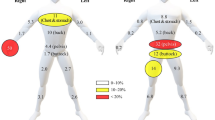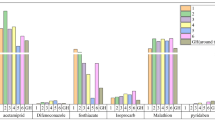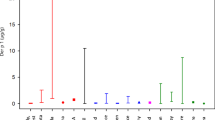Abstract
The aim of this study was to assess exposure to pesticides for a longitudinal epidemiological study on adverse reproduction effects among greenhouse workers. Detailed information on pesticide use among greenhouse workers was obtained on a monthly basis through self-administered questionnaires and subsequent workplace surveys. Questionnaires were filled in for a whole year. Dermal exposure rankings were developed for each task using the observational method Dermal Exposure Assessment Method (DREAM). Exposure scores were calculated for each worker for each month during the year, taking into account frequency, duration and exposure intensity for each task. A total number of 116 different active ingredients were used in the population, whereas a mean number of 15 active ingredients were applied per greenhouse. DREAM observations provided insight into the exposure intensity of 12 application techniques and three mixing and loading activities. Relatively high DREAM scores were obtained for scattering, fogging, dusting, and mixing and loading of powders. Observations with DREAM indicated that application with a horizontal ground-boom, motor driven boom, and bulb shower resulted in low dermal exposure. Exposure scores showed substantial variation between workers and over the year. It can be concluded that exposure variation between- and within greenhouses is very large, both in terms of chemical composition and exposure intensity. This may be a significant contributor to the inconsistent results of studies evaluating health effects of pesticide exposure.
This is a preview of subscription content, access via your institution
Access options
Subscribe to this journal
Receive 6 print issues and online access
$259.00 per year
only $43.17 per issue
Buy this article
- Purchase on Springer Link
- Instant access to full article PDF
Prices may be subject to local taxes which are calculated during checkout

Similar content being viewed by others
References
Blair A., and Zahm S.H. Patterns of pesticide use among farmers: implications for epidemiologic research. Epidemiology 1993: 4 (1): 55–62.
Blair A., Tarone R., Sandler D., Lynch C.F., Rowland A., Wintersteen W., Steen W.C., Samanic C., Dosemeci M., and Alavanja M.C.R. Reliability of reporting on life-style and agricultural factors by a sample of participants in the agricultural health study from Iowa. Epidemiology 2002: 13 (1): 94–99.
Boleij J.S.M., Kromhout H., Fleuren M., Tieleman W., and Verstappen G. Reentry after methomyl application in greenhouses. Appl Occup Environ Hyg 1991: 6 (8): 672–676.
Brouwer D.H., Brouwer E.J., and van Hemmen J.J. Estimation of long-term exposure to pesticides. Am J Ind Med 1994: 25 (4): 573–588.
Buchanan D., Pilkington A., Sewell C., Tannahill S.N., Kid M.W., Cherrie B., and Hurley J.F. Estimation of cumulative exposure to organophosphate sheep dips in a study of chronic neurological health effects among United Kingdom sheep dippers. Occup Environ Med 2001: 58 (11): 694–701.
Cherrie J.W., and Schneider T. Validation of a new method for structured subjective assessment of past concentrations. Ann Occup Hyg 1999: 43 (4): 235–245.
Cherrie J.W., Semple S., Christopher Y., Saleem A., Hughson G.W., and Philips A. How important is inadvertent ingestion of hazardous substances at work? Ann Occup Hyg 2006: 50 (7): 693–704.
Daniels J.L., Olshan A.F., Teschke K., Hertz-Picciotto I., Savitz D.A., and Blatt J. Comparison of assessment methods for pesticide exposure in a case-control study. Am J Epidemiol 2001: 153 (12): 1227–1232.
Dosemeci M., Alavanja M.C.R., Rowland A.S., Mage D., Zahm S.H., Rothman N., Lubin J.H., Hoppin J.A., Sandler D.P., and Blair A. A quantitative approach for estimating exposure to pesticides in the agricultural health study. Ann Occup Hyg 2002: 46 (2): 245–260.
Durham W.F., and Wolfe H.R. Measurement of the exposure of workers to pesticides. Bull World Health Org 1962: 26: 75–91.
Engel L.S., Seixas N.S., Keifer M.C., Longstreth W.T., and Checkoway H. Validity study of self-reported pesticide exposure among orchardists. J Expos Anal Environ Epidemiol 2001: 11 (5): 359–368.
Garcia A.M., Orts E., Esteban V., and Porcuna J.L. Experts' assessment of probability and level of pesticide exposure in agricultural workers. J Occup Environ Med 2000: 42 (9): 911–916.
Hertz-Picciotto I., Pastore L.M., and Beaumont J.J. Timing and patterns of exposures during pregnancy and their implications for study methods. Am J Epidemiol 1996: 143 (6): 597–607.
Krieger R.I., Ross J.H., and Thonginthusak T. Assessing human exposure to pesticides. Rev Environ Contam Toxicol 1992: 128: 1–15.
Kromhout H., and Heederik D. Effects of errors in measurement of agricultural exposures. Scand J Work Environ Health 2005: 31 (Suppl 1): 33–38.
Schneider T., Vermeulen R., Brouwer D.H., Cherrie J.W., Kromhout H., and Fogh C.L. Conceptual model for assessment of dermal exposure. Occup Environ Med 1999: 56 (11): 765–773.
Van Hemmen J.J. Predictive exposure modeling for pesticide registration purposes. Ann Occup Hyg 1993: 37 (5): 541–564.
Van Wendel de Joode B., Brouwer D.H., Vermeulen R., van Hemmen J.J., Heederik D., and Kromhout H. DREAM: a method for semi-quantitative dermal exposure assessment. Ann Occup Hyg 2003: 47 (11): 71–87.
Van Wendel de Joode B., van Hemmen J.J., Meijster T., Major V., London L., and Kromhout H. Reliability of a semi-quantitative method for dermal exposure assessment (DREAM). J Expos Anal Environ Epidemiol 2005a: 15: 111–120.
Van Wendel de Joode B., Vermeulen R., van Hemmen J.J., Fransman W., and Kromhout H. Accuracy of a semi-quantitative method for dermal exposure assessment (DREAM). Occup Environ Med 2005b: 62: 623–632.
Ward M.H., Prince J.R., Stewart P.A., and Zahm S.H. Determining the probability of pesticide exposures among migrant farmworkers: results from a feasibility study. Am J Ind Med 2001: 40 (5): 538–553.
Wegman D.H., Eisen E.A., Woskie S.R., and Hu X. Measuring exposure for the epidemiologic study of acute effects. Am J Ind Med 1992: 21 (1): 77–89.
Acknowledgements
This publication is based on work sponsored by the Dutch Ministry of Social Affairs and Employment and Netherlands Organisation for Scientific Research. Marc Lurvink has performed an important part of the field observations. All greenhouse owners and workers are acknowledged for their participation in this exposure assessment survey.
Author information
Authors and Affiliations
Corresponding author
Rights and permissions
About this article
Cite this article
Tielemans, E., Bretveld, R., Schinkel, J. et al. Exposure profiles of pesticides among greenhouse workers: implications for epidemiological studies. J Expo Sci Environ Epidemiol 17, 501–509 (2007). https://doi.org/10.1038/sj.jes.7500544
Received:
Accepted:
Published:
Issue Date:
DOI: https://doi.org/10.1038/sj.jes.7500544
Keywords
This article is cited by
-
Pesticide use patterns and their association with cytokine levels in Mexican flower workers
International Archives of Occupational and Environmental Health (2024)
-
Analytical method for assessing potential dermal exposure to pesticides of a non-agricultural occupationally exposed population
Analytical and Bioanalytical Chemistry (2011)



